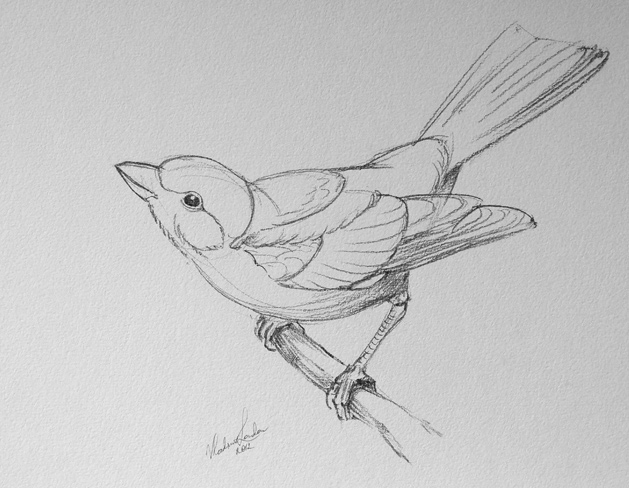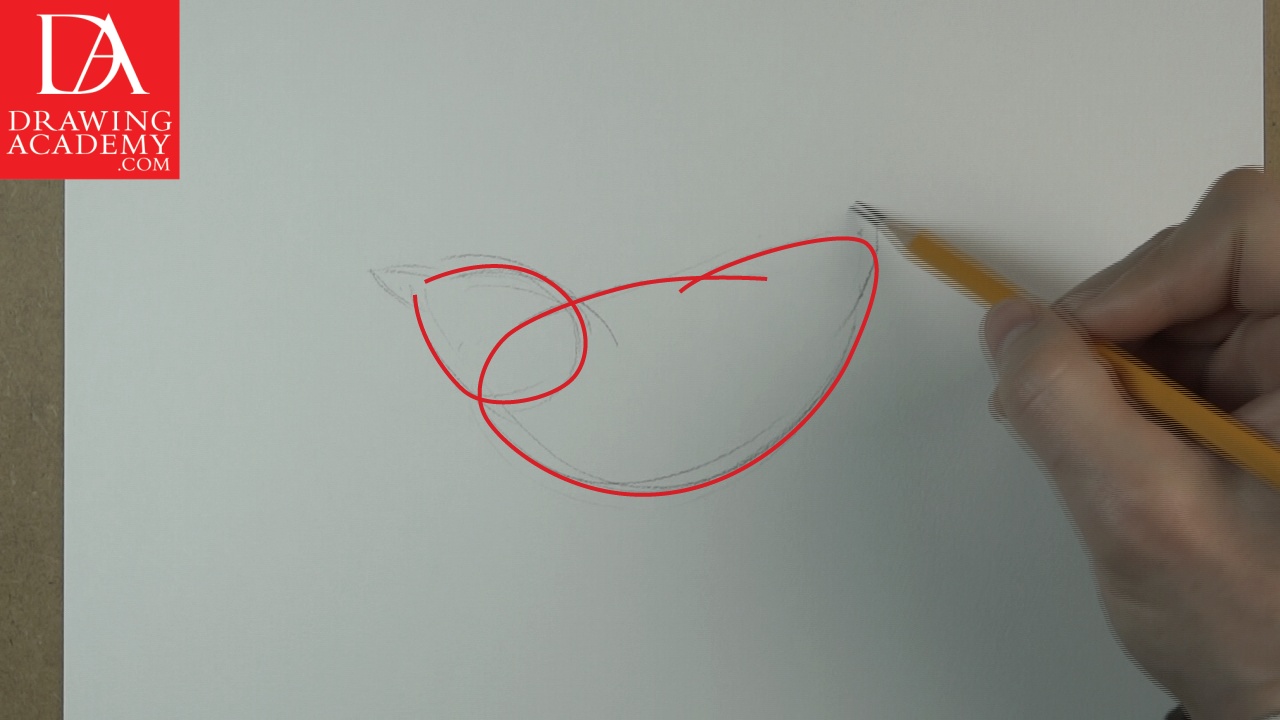Discover How to Draw a Bird
In this video lesson, you will discover how to draw a bird in a realistic manner.
Enroll in the Drawing Academy Course
Pay once - Enjoy forever!
Only $297
How to Draw a Bird Step by Step

How to draw a bird is an interesting subject. There are thousands of bird species on this planet. They have various sizes and shapes. However, the majority of them have common and easily recognizable elements of their body.
We begin this “How to Draw a Bird” video lesson with a simple rounded shape of the bird’s body, which looks like a peanut pointed at one end. The head and neck are also sketched in a very simple outline.

This bird’s tail has a trapezium shape, although tail shapes vary vastly from species to species.
When it come to a question of “How to Draw a Bird”, drawing birds in nature is quite challenging; usually you will not have much time before a bird moves, changes the pose or even flies away. So making a rapid outline of the bird’s body, head and tail will give a nice indication of the pose and attitude.
When considering ‘How to Draw a Bird’, keep in mind the following parts of a bird’s body.
There is a crown on the top of the bird’s head.
Many birds have a crest on the crown and can manipulate their crown by raising and lowering their feathers for a courtship display or territorial defence. The crown’s plumage can be brightly colored.
The back of a bird’s neck is called the nape. The nape color often matches the crown or back. Depending on the length of the bird’s neck, the nape can be short or long. It goes from the base of the skull down to the upper back.
Most often, birds’ eyes are located on the sides of their head, giving them a wider angle of vision, which helps them escape from predators. However, birds of prey, for example owls, have eyes in front of their head for a better binocular focus, which helps them to estimate distances when hunting.
Behind their eyes, there are ear-coverts. Birds do not have pinna, which is the external visible part of the human ear.
There are an immense variety of beaks in nature. Even some birds of the same family have differently shaped beaks depending on the kind of food they feed on. The beak is also called a bill or rostrum. It is used for eating, grooming, manipulating objects, killing prey, fighting, probing for food, courtship and feeding young.
Then there is the chin under the beak. The chin is very small and doesn’t protrude. Next comes the throat. Then further down is the breast.
The bird’s mantle is located on its back behind its neck. When a bird is at rest, the mantle is often hard to distinguish from its wings if they are similarly colored.
Small feathers at the base of the wing’s leading edge are called scapulas. They cover the bird’s shoulders.
The bird’s wings consist of several groups of feathers. There are Marginal coverts that overlap Secondary coverts, which in turn overlap Secondaries. Next to the Marginal coverts there is the Alula, followed by the Primary coverts, which overlap the Primaries.
When considering ‘How to Draw a Bird’, keep in mind that the anatomy of the bird’s wing resembles the anatomy of the human arm and hand. Here is the drawing of the bird’s wing bones and feathers.
Flight feathers are long, stiff and symmetrically paired on both wings. Every feather is asymmetrical, the side facing the leading edge is narrower and called the outer vane and the opposite side is wider and called the inner vane.
Feathers are attached to birds in linear tracts. Birds usually have the densest area for feathers on their head and neck.
Birds have different types of feathers, the main ones of them are:
– Contour feathers which are visible on the bird’s surface and overlap each other. They provide the color and the shape of the bird and also protect them from rain.
– Remiges are the largest of the contour feathers which are used for flight. The largest and strongest of the remiges are primaries. They are attached to bones that are equivalent to the “hand”. The Secondaries are inner remiges and attached to the “forearm”. During flight, secondaries feathers provide lift.
– Rectrices are the feathers of the tail. Only the innermost rectrices attach directly to the tailbone while other tail feathers are connected to each other by ligaments.
– Coverts are feathers on both the upper and lower parts of the bird’s body. They insulate the bird and streamline its body.
There are also other types of feathers like: afterfeather, bristles, down feathers, semiplumes, filoplumes and powder downs. However, these feathers influence less the bird’s shape and colour.
The bird’s tail has many functions, with the most important of them assisting flight by keeping the balance, providing the lift, changing flight direction and changing the geometry during high and low speeds of flight. Bird’s tails also can have many other functions. For example, it serves a decorative purpose for male peacocks to attract the opposite sex; or being the support for a woodpecker to maintain its grip while acquiring wood-boring grubs using their bills for hammering. The muscles of the tail also aid in helping the bird expand its lungs to take in extra air when needed.
Flanks are the sides of a bird’s body between the wing and the legs. Flanks are sometimes differently colored and used for a bird’s identification.
Birds’ legs are the heaviest bones in the skeleton. The skeleton itself is very light; it comprises only about 5% of the bird’s body weight.
Bird’s legs are cleverly engineered. In extreme cold weather they don’t get frostbite despite them not being covered in feathers. For example, gulls and penguins have blood vessels going into the legs, which lie right next to the blood vessels leaving the legs. So the temperature of the up-and-down blood stream is even faster and prevents heat from being lost to the cold air. Also, the scales on their feet are less likely to get frostbitten than human skin.
Birds have very good eyesight. Birds of prey, for example, have vision eight times sharper than humans. This is due to the higher density of photoreceptors in the retina, which is the layer inside of the eye that detects light. Birds also have a higher number of optic nerves and sometimes an indented fovea, which is the central spot inside the eye. This fovea magnifies the central part of the visual field. Bird species like hummingbirds and albatrosses have two foveae in each eye.
Birds have a large brain compared to the mass of its body. This reflects in their advanced and complex behavior and intelligence.




